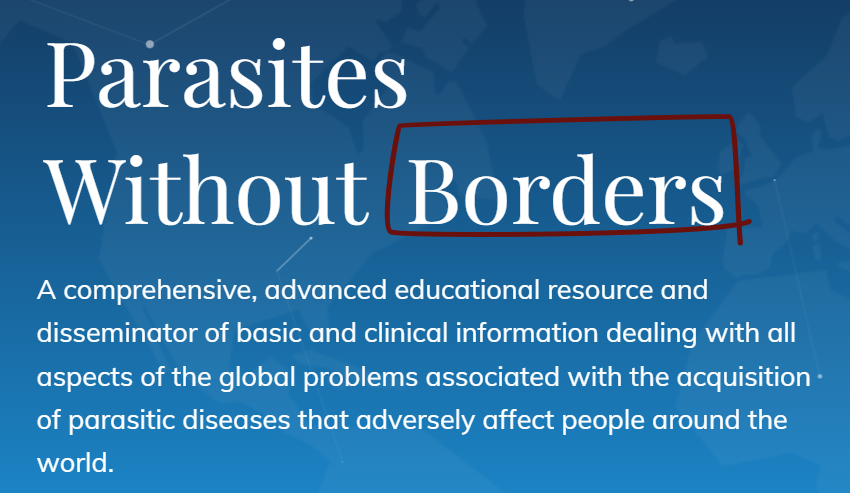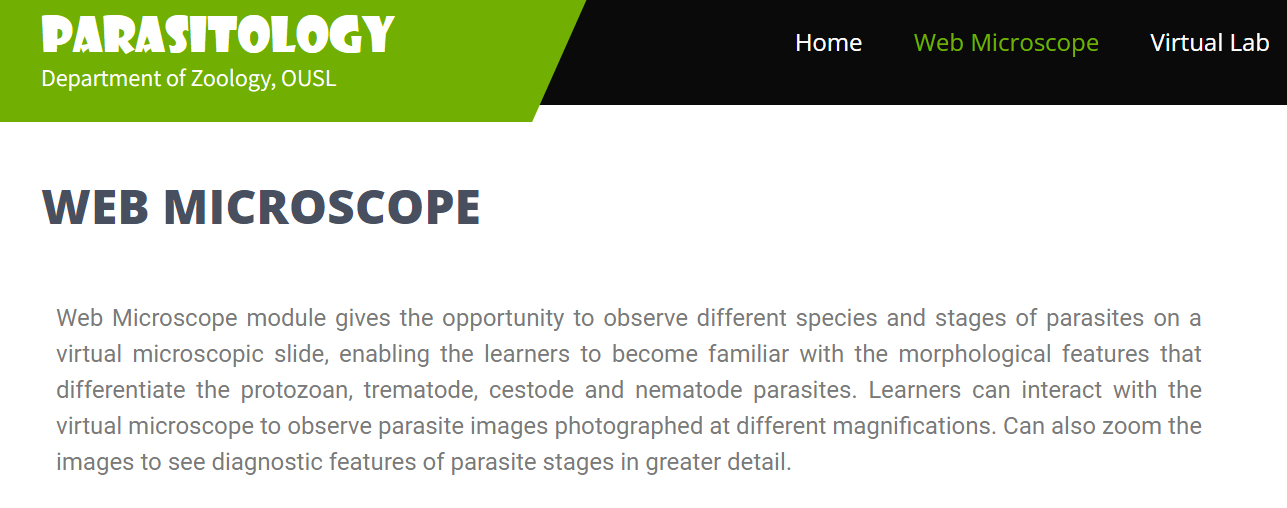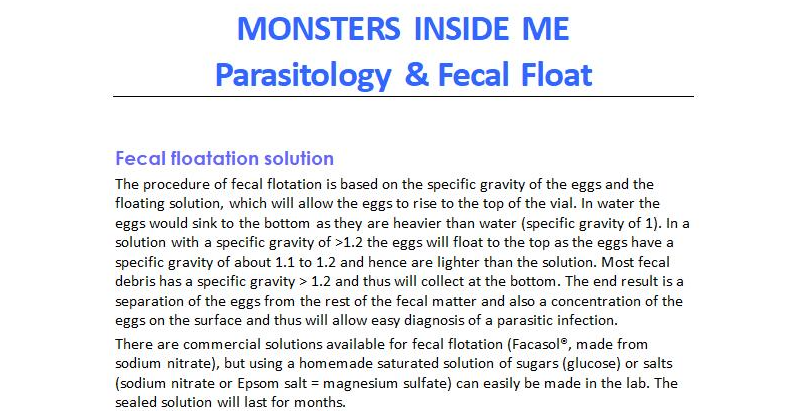Modules – Skills & Tools
Parasitology
Background Information
Where to start? Parasites are amazing and they have been associated with living creatures and co-evolved and entered an arms-race since the beginning of life on earth! Although you may not think of parasites are very common in the Western world, it is a huge economic problem in livestock, pets and even in humans. Not just in poor countries, but even in the USA, on your doorstep, parasitic infections affect millions of Americans, regardless of socioeconomic status. The five neglected parasitic disease in the US are Chagas disease, cysticercosis, toxocariasis, toxoplasmosis, and trichomoniasis, according to the CDC. Out of this list, my favorite is Toxoplasma gondii, hands down. This mind altering parasite makes enemies love each other (check out Ed Yong’s TED talk “Zombie roaches and other parasite tales“, minute 9:30 min, talks about Toxoplasma, the parasites changes the behavior of rats to be attracted to cats……by producing dopamine…and can change the behavior of humans, too!)
“Humans are hosts to nearly 300 species of parasitic worms and over 70 species of protozoa, some derived from our primate ancestors and some acquired from the animals we have domesticated or come in contact with during our relatively short history on Earth. Our knowledge of parasitic infections extends into antiquity, and descriptions of parasites and parasitic infections are found in the earliest writings and have been confirmed by the finding of parasites in archaeological material.” (1)
This video is of Trypanosoma brucei, a parasite I studied for my PhD, transmitted by the Tsetse fly and prevalent in sub-Saharan Africa. The parasite lives in the blood and can invade the brain where it causes neurological problems. I studied the evolution and function of a protein that contributed to the molecular arms race between the parasite and their host (2.3). The image depicts a 3D illustration of the Malaria parasite multiplying within a red blood cell being released into the bloodstream.
Learning Objectives
After completing this module, students will be able to:
-
- Recall new vocabulary and definitions that pertain to this module.
- Compare and contrast commensal, symbiotic, and pathogenic relationships.
- Explain the method of how a fecal float is conducted.
- Utilize resources to identify fecal derived parasitic eggs.
- Examine the occurrence of a variety of parasitic diseases worldwide.
- Recall how mind control is executed by a variety of parasites.
- Appreciate the co-evolution of humans and parasites over millions of years.
Access OpenStax:
4.1 Prokaryote Habitats, Relationships, and Microbiomes
5.1 Unicellular Eukaryotic Parasites
5.2 Parasitic Helminths
The department offers an elective “Human Parasitology” MCB4232 taught by Dr. Kima
History Connections
Next time you are in Washington DC, visit the Keck building of the National Academy of Sciences and check out the scientific history in the main lobby by Larry Kirkland (free of charge) @ 500 Fifth Street, NW (bottom left, malaria parasite, picture taken by Dr. Oli)
CASE STUDY
Case #1: (picture center) Misty loves running with Dr. Oli in San Felasco state park. A few days after visiting the park, her daughter Maya found 2 ticks on Misty and sent this photo to her mom to ask about the weird red ring about only around one of the ticks. What’s the verdict for Misty?
Case #2: (picture right) Misty completed her annual vet visit without any problems and symptoms, her fecal examination came back negative and all her vitals were OK. The weekend following, Dr Oli noticed some “white rice-like items” on Misty’s fecal matter. What’s wrong with Misty?
Virtual Lab Simulations
Parasites Without Borders:
Great parasitology resource; offers free extensive lectures and textbooks on parasitology!
Online Lab
Activity: Monsters Inside Me
1. Pick Your Favorite Parasite
There are so many cool parasites and different ways to be a parasite! For example, brain eating amoeba or the jewel wasp that enslaves cockroaches or Toxoplasma that makes rats love cats.
- Use GIDEON to understand how to identify yeasts and examine diseases, treatment and distribution for one of the parasitic diseases listed in GIDEON
- Pick one parasite and corresponding disease and explain how the organism is identified, how the symptoms manifest, how the disease is treated and where it occurs
- Look at the specific life cycle at the CDC website https://www.cdc.gov/dpdx/az.html
-
Check out clinical diagnostic tests for your parasite https://www.cdc.gov/parasites/references_resources/diagnosis.html http://dpd.cdc.gov/dpdx/Default.htm
2. Exploring Topics of Parasitology
Pick one of the topics below and explore the role of parasites. Describe the purpose, science behind it and implications. Back your findings up with scientific references and share the results with the class. Submit your findings in the appropriate assignment.
What you may have never heard about any of these topics. Parasites have evolved with us and with all living beings and they are good at being parasites. Check it out!
Pick one of the topics and explore scientific papers that explain the science behind it and implications or applications
Ant blade sheep fluke
Antigenic variation
Antigenic variation in parasites: purpose, evolution and genetics
Archaeoparasitology
Arms race
Arms race
Benefits of parasites
Eradication of malaria in Florida
Helminth therapy
Leech and maggot therapy
Malaria
Mind control
Nest/Brood parasites
Parasites and climate change
Parasites that transmit other diseases
Parasitic castrator
Parasitic insects
Parasitic mind control
Sleeping sickness
Toxoplasma – behavior changes
Wasp cockroach
Zombie fungus
Parasite vectors
Development efforts and parasites (damming, resettlement)
Results
Include in your ELN your findings for both of the activities above! Make sure you include your sources (just links are okay!). You can also use the virtual lab simulation links as helpful resources!
In-Person Lab
Activity: Parasitology and Fecal Float
Video Tutorials
Fecal Float
Resources
REAL-WORLD APPLICATION
- Monsters inside me (Animal Planet show)
- MUST WATCH 3 year old with intestinal worms emergency surgery
- Mosquito Game
- http://www.nobelprize.org/educational/medicine/malaria/about.html
- Canine heartworm disease
- Heartworm extraction surgery
Merck Manual: Approach to Parasitic Infections
this is a great overview of the main groups of parasites and main diagnostic methods
One key method of detecting intestinal parasites is the fecal float method, which is performed in the life lab
The fecal flotation procedure is used routinely to look for various eggs, cysts and ameba, which are indicative of parasitic infections of humans and animals. Many parasites spend a part of their life cycle in the GI (gastrointestinal tract) of their host. Life parasites, their eggs or encysted life forms can be found in the fecal matter.
Examples of commonly found parasites in the feces of pets in Florida are Helminths eggs, which includes hook worms (Ancylostoma spp.), round worms (Ascaris spp) and tapeworms (Dipyliidium). Other parasites often found include Giardia (diplomonads), Cryptosporidium (apicomplexa) and Toxoplasma (apicomplexa) cysts. All these parasites are commonly diagnosed through the fecal flotation method.
To identify your parasite eggs go to Novartis Internal Manual for dogs and Cats
To learn about parasitic diseases check out GIDEON
For life cycle description of parasites go to the CDC homepage on parasites
Fecal float DYI description and video (with Paula Rios Glusberger)




